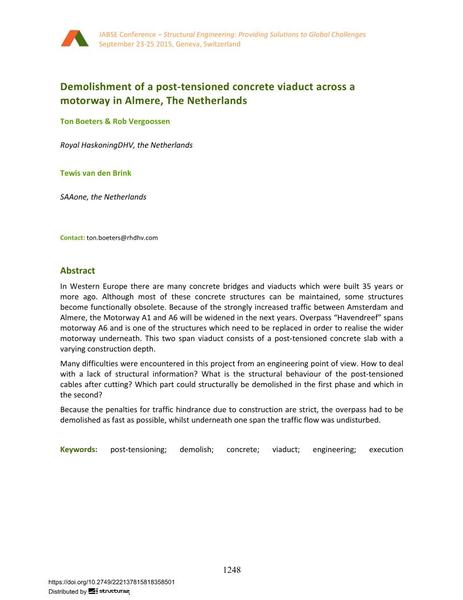Demolishment of a post-tensioned concrete viaduct across a motorway in Almere, The Netherlands

|
|
|||||||||||
Détails bibliographiques
| Auteur(s): |
Ton Boeters
(Royal HaskoningDHV, the Netherlands)
Rob Vergoossen (Royal HaskoningDHV, the Netherlands) Tewis van den Brink (SAAone, the Netherlands) |
||||
|---|---|---|---|---|---|
| Médium: | papier de conférence | ||||
| Langue(s): | anglais | ||||
| Conférence: | IABSE Conference: Structural Engineering: Providing Solutions to Global Challenges, Geneva, Switzerland, September 2015 | ||||
| Publié dans: | IABSE Conference Geneva 2015 | ||||
|
|||||
| Page(s): | 1248-1254 | ||||
| Nombre total de pages (du PDF): | 7 | ||||
| Année: | 2015 | ||||
| DOI: | 10.2749/222137815818358501 | ||||
| Abstrait: |
In Western Europe there are many concrete bridges and viaducts which were built 35 years or more ago. Although most of these concrete structures can be maintained, some structures become functionally obsolete. Because of the strongly increased traffic between Amsterdam and Almere, the Motorway A1 and A6 will be widened in the next years. Overpass “Havendreef” spans motorway A6 and is one of the structures which need to be replaced in order to realise the wider motorway underneath. This two span viaduct consists of a post-tensioned concrete slab with a varying construction depth. Many difficulties were encountered in this project from an engineering point of view. How to deal with a lack of structural information? What is the structural behaviour of the post-tensioned cables after cutting? Which part could structurally be demolished in the first phase and which in the second? Because the penalties for traffic hindrance due to construction are strict, the overpass had to be demolished as fast as possible, whilst underneath one span the traffic flow was undisturbed. |
||||
| Mots-clé: |
viaduc béton
|
||||
